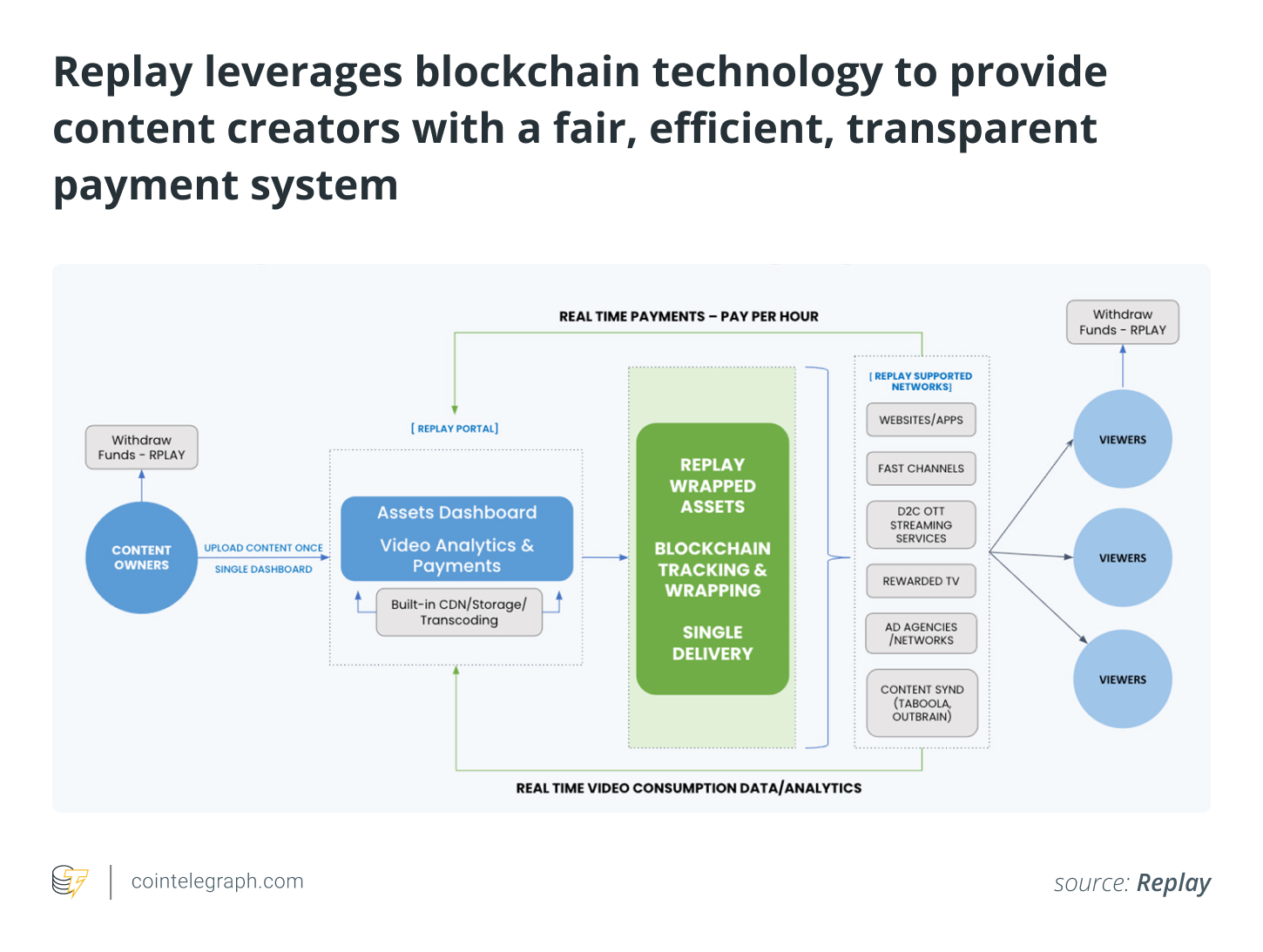 Imagine a digital business model called StreamChain, a decentralized streaming service that merges the seamless, on-demand video experience of Netflix with the transparency and incentivization of blockchain and cryptocurrency.
Imagine a digital business model called StreamChain, a decentralized streaming service that merges the seamless, on-demand video experience of Netflix with the transparency and incentivization of blockchain and cryptocurrency.
StreamChain offers a vast library of movies, TV shows, and original content, accessible globally through apps or web browsers, with AI-driven recommendations tailoring the experience to each user’s viewing habits.
Unlike traditional platforms, StreamChain minimizes region-locking by using blockchain to streamline cross-border licensing, making content more accessible worldwide.
Replay
Replay offers a reference example for this scenario. As CoinTelegraph describes:
“The global video streaming market is expected to reach $416.84 billion by 2030, registering a compound annual growth rate of 21.5% from 2023 to 2030. Despite the growth of the industry, the current streaming models — subscription-based (SVOD), ad-supported (AVOD) and transactional video on demand (TVOD) — have significant drawbacks, including fragmentation, opaque payment structures and a lack of opportunities for engagement for both content owners and viewers.
Tackling all these challenges, Replay, a Web3 streaming platform built on Theta’s Core Blockchain, introduces a unified streaming ecosystem powered by blockchain technology. Instead of relying on intermediaries, Replay aggregates content into an easy-to-navigate platform and directly connects content creators and consumers.”
Decentralized Architecture
At its core, StreamChain operates on a decentralized network, leveraging blockchain technology to transform how content is hosted, licensed, and monetized. Instead of relying on centralized servers, content is stored across a distributed network, similar to IPFS or a custom blockchain, where users with spare storage or bandwidth can act as nodes and earn cryptocurrency rewards.
Smart contracts automate licensing agreements and royalty payments, ensuring creators receive instant, transparent payouts without intermediaries. Every interaction, from viewing history to revenue splits, is recorded on the blockchain, fostering trust and enabling verifiable auditing of platform usage.

Micro Economy
The platform introduces its own cryptocurrency, STREAM, which powers all transactions. Users purchase subscriptions with STREAM, acquired through fiat or other cryptocurrencies like Bitcoin or Ethereum via integrated exchanges.
Beyond subscriptions, StreamChain incentivizes engagement by rewarding users with small amounts of STREAM for actions like watching ads, reviewing content, or referring friends, gamifying the experience and reducing subscriber churn.
Creators benefit from direct royalty payments based on viewership, with top contributors potentially earning tokenized “equity” in the platform. For premium or exclusive content, such as early movie releases, users can make micropayments in STREAM, bypassing traditional paywalls and enhancing flexibility.
Revenue Model
StreamChain’s revenue model is multifaceted, ensuring sustainability and growth. The primary income comes from tiered subscriptions—Basic, Premium, and Ultra—offering different resolutions and features, all paid in STREAM. Small transaction fees on STREAM purchases or premium content payments support platform operations.
Optional ads for non-subscribers or users seeking extra STREAM generate additional revenue, with advertisers paying in the platform’s token. A portion of subscription revenue also rewards node operators who host content, ensuring the network remains scalable and decentralized.
Gamification and Rewards
This model delivers unique benefits for both users and creators. Users gain transparency into how their subscription fees are distributed—to creators, the platform, or node operators—thanks to blockchain’s immutable ledger. Holding STREAM tokens offers a sense of ownership, with potential value appreciation as the platform grows.
The use of cryptocurrency also makes StreamChain accessible in underbanked regions, bypassing traditional banking barriers. For creators, smart contracts ensure instant royalty payments, while transparent, blockchain-based analytics provide insights into viewership trends, enabling data-driven content creation. Creators can also launch tokenized crowdfunding campaigns for new projects, offering backers exclusive content or STREAM rewards.
Gamification involves applying game-like elements—such as rewards, challenges, and progression systems—to non-game contexts to motivate user behavior and enhance engagement. For StreamChain, a key gamification strategy is the use of its native STREAM token as a reward mechanism, incentivizing actions like watching ads, reviewing content, or referring new subscribers. Users, like Alice, might earn 0.1 STREAM for completing a post-viewing survey or 0.5 STREAM for a successful referral, creating a sense of achievement akin to earning points in a game.
Another gamification strategy is the implementation of progression systems, where users unlock benefits or status as they engage more deeply with the platform. StreamChain could introduce tiered user levels—such as Viewer, Supporter, and Ambassador—based on accumulated STREAM earnings or platform activity, like hours watched or nodes hosted. Higher tiers might unlock exclusive content, early access to releases, or increased node rewards, fostering a sense of progression similar to leveling up in a game.
Feedback loops and visual cues reinforce these gamification strategies by making progress tangible. StreamChain could display real-time notifications, like “You’ve earned 0.2 STREAM for reviewing this film!” or progress bars tracking challenge completion, providing instant feedback that sustains user motivation.
Blockchain Design
Technically, StreamChain is built on a high-throughput blockchain, such as Solana or a custom layer-1 solution, to handle fast, low-cost transactions. Decentralized storage solutions like IPFS or Arweave ensure content is censorship-resistant and always available, while a peer-to-peer streaming protocol minimizes latency for smooth playback.
To address challenges, StreamChain employs layer-2 scaling solutions to manage transaction costs and streaming demands, partners with legal entities to comply with copyright and financial regulations, and provides a user-friendly interface to hide blockchain complexity, with fiat on-ramps for non-crypto users.
Unique Model
StreamChain’s competitive edge lies in its cost efficiency, community-driven ecosystem, and global accessibility. By decentralizing hosting and automating payments, it reduces overhead compared to Netflix’s centralized model. Token incentives align the interests of users, creators, and node operators, fostering loyalty and growth.
Cryptocurrency payments and blockchain technology enable seamless access in regions with restrictive banking or censorship, positioning StreamChain as a forward-thinking alternative in the streaming industry.
Consider a user, Alice, who joins StreamChain by purchasing STREAM tokens through a fiat gateway. She subscribes to the Premium plan for $10/month, paid in STREAM, and watches a new indie film, earning 0.1 STREAM for completing a survey.
The film’s creator instantly receives 70% of her subscription fee via a smart contract. Meanwhile, Alice’s spare hard drive hosts part of the content library, earning her 0.5 STREAM daily. This ecosystem blends Netflix’s user-friendly streaming with blockchain’s transparency and cryptocurrency’s financial flexibility, creating a scalable, incentivized platform for creators and consumers alike.




